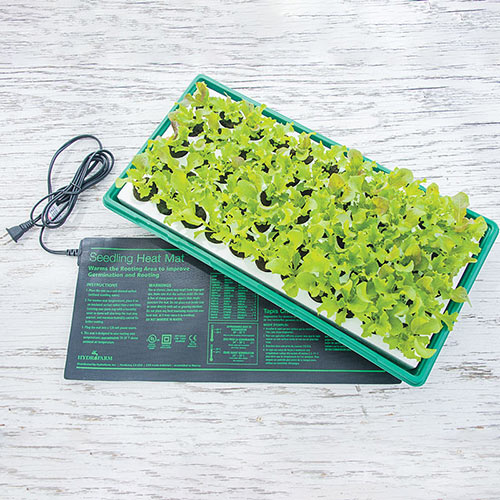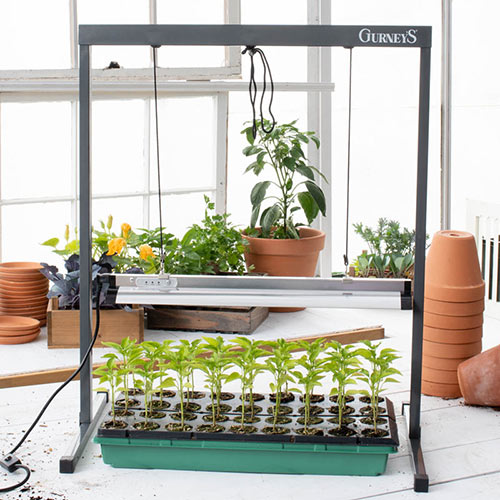Getting Started for Seed Starting
-
Helpful Products from Gardens Alive!
-
 Seedling Starter Heat Mat
Seedling Starter Heat Mat -
 Grow Light
Grow Light
Q. Brandon from Conshohocken (PA) writes: "Could you please discuss wood vs peat based potting soils on your show? I've heard that the wood-based ones are better for a variety of reasons, but I have mixed feelings since they drain really well but don't seem to retain much moisture near the soil surface. I typically do the finger test in my pots rather than rocking them, and it's always parched to the 2nd knuckle within a day with wood-based soil, then I go to water and realize there's still a ton of water in the bottom half of the pot and I end up with an overflowing drip tray. I haven't noticed any difference in plant health, but I don't do side-by-side comparisons."
A. I had no idea what Brandon was talking about until a quick search revealed a company selling bagged potting soil that included wood labeled as "potting soil and mulch", a phrase I had also never heard before. A typical potting soil would make a lousy mulch and a typical mulch would make a lousy potting soil. The company 'explains' that the "wood fines" they include in their mixes "force soil particles apart, allowing water and air to travel down away from the surface and towards plant root systems". In other words, they're substituting small pieces of wood for perlite, my favorite soil conditioner. This mined volcanic material is popped into little balls that provide excellent drainage but also hold onto excess moisture in their honeycombed interior and release it when the soil gets too dry.
Now, as all good You Bet Your Gardeners know, wood absorbs and sequesters plant-feeding Nitrogen while depriving the actual plants of this essential nutrient, especially when the wood is mixed into the soil. So that's Strike One. Strike Two is called by The Umpire of Gardening because of their very next line, where they add that "it is critical to mix soil amendments or planting mixes with your native soil rather than using them "straight".
NEVER use garden soil to start seeds or repot plants. Never ever ever! You'll wind up with weeds whose seeds were lurking in your outdoor soil, possible disease organisms that were hanging out with the weed seeds, and a soil consistency that is the opposite of what you want for growing healthy seedlings. I would proceed to read more of their malarky and have Strike Three called but I read more than enough already; so I'll throw at them, hit them on the back, which will put them on first and then pick them off when they try to steal Second. Wood? Are you kidding me? Wood?!
Back to Brandon: Sorry pal but you (like 90 percent of our gardening kats and kittens) are also watering WAY incorrectly. Nobody cares if the soil surface is dry! It means nothing! As we have repeatedly been saying repeatedly, it's the root area that counts. Stick a long chopstick or Shish Kabob holder down to the BOTTOM of the pot and let it sit there for a few minutes. If the tip is wet when you pull it out, your roots are still saturated. Let them dry out before you water again. Intelligent withholding of water is HUGELY important, especially with new starts. Too much water = damping off disease.
There are many excellent non-wooden organic potting soils out there. Please don't use Miracle-Gag or "I lost my Osmo-coat", or other potting soils that contain toxic chemical salts. Organic potting soils contain lots of groovy natural plant food, like worm castings and such.
Timing: If you have some gardening experience and think you're up for it, starting your own seeds indoors is enlightening and wonderful. But if you're just getting started growing things, DON'T DO IT! IT'S A TRAP DESIGNED TO DESTROY YOUR CONFIDENCE!
Seriously, starting seeds indoors is a much different skill than growing plants outdoors. First timers are encouraged to buy plants like tomatoes and peppers already professionally started. You can test your seed-starting skills outdoors with 'direct-seeded' crops like lettuce, spinach and string beans.
OK; timing. My rule is to start your seeds exactly two months before you intend to set the plants out. Research the historical weather data for your region for the past five April, May and Junes. That should give you an idea when NIGHTIME temps typically stay in the fifties.
That's right Kats and Kittens; your "last average frost date" means NOTHING! Frost is not the issue here. Tropical plants like tomatoes, peppers, cukes, melons, etc. suffer greatly when temps are in the high 30s and mid-to-low forties. You're looking for nighttime temps in the fifties. For instance, I typically start my plants around March 15th for (hopeful) planting out somewhere around May 15. But if nights are still cold then, I keep them inside until the ten-day forecast shows nights in the fifties. 48 or 49? No problem. 42 or 43? That's a chump move.
A. I had no idea what Brandon was talking about until a quick search revealed a company selling bagged potting soil that included wood labeled as "potting soil and mulch", a phrase I had also never heard before. A typical potting soil would make a lousy mulch and a typical mulch would make a lousy potting soil. The company 'explains' that the "wood fines" they include in their mixes "force soil particles apart, allowing water and air to travel down away from the surface and towards plant root systems". In other words, they're substituting small pieces of wood for perlite, my favorite soil conditioner. This mined volcanic material is popped into little balls that provide excellent drainage but also hold onto excess moisture in their honeycombed interior and release it when the soil gets too dry.
Now, as all good You Bet Your Gardeners know, wood absorbs and sequesters plant-feeding Nitrogen while depriving the actual plants of this essential nutrient, especially when the wood is mixed into the soil. So that's Strike One. Strike Two is called by The Umpire of Gardening because of their very next line, where they add that "it is critical to mix soil amendments or planting mixes with your native soil rather than using them "straight".
NEVER use garden soil to start seeds or repot plants. Never ever ever! You'll wind up with weeds whose seeds were lurking in your outdoor soil, possible disease organisms that were hanging out with the weed seeds, and a soil consistency that is the opposite of what you want for growing healthy seedlings. I would proceed to read more of their malarky and have Strike Three called but I read more than enough already; so I'll throw at them, hit them on the back, which will put them on first and then pick them off when they try to steal Second. Wood? Are you kidding me? Wood?!
Back to Brandon: Sorry pal but you (like 90 percent of our gardening kats and kittens) are also watering WAY incorrectly. Nobody cares if the soil surface is dry! It means nothing! As we have repeatedly been saying repeatedly, it's the root area that counts. Stick a long chopstick or Shish Kabob holder down to the BOTTOM of the pot and let it sit there for a few minutes. If the tip is wet when you pull it out, your roots are still saturated. Let them dry out before you water again. Intelligent withholding of water is HUGELY important, especially with new starts. Too much water = damping off disease.
There are many excellent non-wooden organic potting soils out there. Please don't use Miracle-Gag or "I lost my Osmo-coat", or other potting soils that contain toxic chemical salts. Organic potting soils contain lots of groovy natural plant food, like worm castings and such.
Timing: If you have some gardening experience and think you're up for it, starting your own seeds indoors is enlightening and wonderful. But if you're just getting started growing things, DON'T DO IT! IT'S A TRAP DESIGNED TO DESTROY YOUR CONFIDENCE!
Seriously, starting seeds indoors is a much different skill than growing plants outdoors. First timers are encouraged to buy plants like tomatoes and peppers already professionally started. You can test your seed-starting skills outdoors with 'direct-seeded' crops like lettuce, spinach and string beans.
OK; timing. My rule is to start your seeds exactly two months before you intend to set the plants out. Research the historical weather data for your region for the past five April, May and Junes. That should give you an idea when NIGHTIME temps typically stay in the fifties.
That's right Kats and Kittens; your "last average frost date" means NOTHING! Frost is not the issue here. Tropical plants like tomatoes, peppers, cukes, melons, etc. suffer greatly when temps are in the high 30s and mid-to-low forties. You're looking for nighttime temps in the fifties. For instance, I typically start my plants around March 15th for (hopeful) planting out somewhere around May 15. But if nights are still cold then, I keep them inside until the ten-day forecast shows nights in the fifties. 48 or 49? No problem. 42 or 43? That's a chump move.
-
Helpful Products from Gardens Alive!
-
 Seedling Starter Heat Mat
Seedling Starter Heat Mat -
 Grow Light
Grow Light







 Gardens Alive! & Supplies
Gardens Alive! & Supplies




